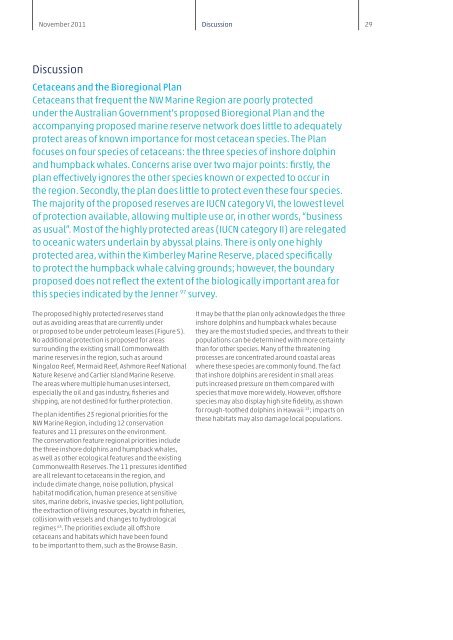Australia's last great whale haven.pdf - Ningaloo Atlas
Australia's last great whale haven.pdf - Ningaloo Atlas
Australia's last great whale haven.pdf - Ningaloo Atlas
- TAGS
- whale
- ningaloo
- atlas
- www.ifaw.org
You also want an ePaper? Increase the reach of your titles
YUMPU automatically turns print PDFs into web optimized ePapers that Google loves.
November 2011 Discussion<br />
29<br />
Discussion<br />
Cetaceans and the Bioregional Plan<br />
Cetaceans that frequent the NW Marine Region are poorly protected<br />
under the Australian Government’s proposed Bioregional Plan and the<br />
accompanying proposed marine reserve network does little to adequately<br />
protect areas of known importance for most cetacean species. The Plan<br />
focuses on four species of cetaceans: the three species of inshore dolphin<br />
and humpback <strong>whale</strong>s. Concerns arise over two major points: firstly, the<br />
plan effectively ignores the other species known or expected to occur in<br />
the region. Secondly, the plan does little to protect even these four species.<br />
The majority of the proposed reserves are IUCN category VI, the lowest level<br />
of protection available, allowing multiple use or, in other words, “business<br />
as usual”. Most of the highly protected areas (IUCN category II) are relegated<br />
to oceanic waters underlain by abyssal plains. There is only one highly<br />
protected area, within the Kimberley Marine Reserve, placed specifically<br />
to protect the humpback <strong>whale</strong> calving grounds; however, the boundary<br />
proposed does not reflect the extent of the biologically important area for<br />
this species indicated by the Jenner 97 survey.<br />
The proposed highly protected reserves stand<br />
out as avoiding areas that are currently under<br />
or proposed to be under petroleum leases (Figure 5).<br />
No additional protection is proposed for areas<br />
surrounding the existing small Commonwealth<br />
marine reserves in the region, such as around<br />
<strong>Ningaloo</strong> Reef, Mermaid Reef, Ashmore Reef National<br />
Nature Reserve and Cartier Island Marine Reserve.<br />
The areas where multiple human uses intersect,<br />
especially the oil and gas industry, fisheries and<br />
shipping, are not destined for further protection.<br />
The plan identifies 23 regional priorities for the<br />
NW Marine Region, including 12 conservation<br />
features and 11 pressures on the environment.<br />
The conservation feature regional priorities include<br />
the three inshore dolphins and humpback <strong>whale</strong>s,<br />
as well as other ecological features and the existing<br />
Commonwealth Reserves. The 11 pressures identified<br />
are all relevant to cetaceans in the region, and<br />
include climate change, noise pollution, physical<br />
habitat modification, human presence at sensitive<br />
sites, marine debris, invasive species, light pollution,<br />
the extraction of living resources, bycatch in fisheries,<br />
collision with vessels and changes to hydrological<br />
regimes 63 . The priorities exclude all offshore<br />
cetaceans and habitats which have been found<br />
to be important to them, such as the Browse Basin.<br />
It may be that the plan only acknowledges the three<br />
inshore dolphins and humpback <strong>whale</strong>s because<br />
they are the most studied species, and threats to their<br />
populations can be determined with more certainty<br />
than for other species. Many of the threatening<br />
processes are concentrated around coastal areas<br />
where these species are commonly found. The fact<br />
that inshore dolphins are resident in small areas<br />
puts increased pressure on them compared with<br />
species that move more widely. However, offshore<br />
species may also display high site fidelity, as shown<br />
for rough-toothed dolphins in Hawaii 13 ; impacts on<br />
these habitats may also damage local populations.

















